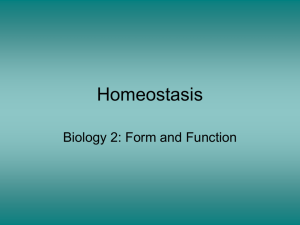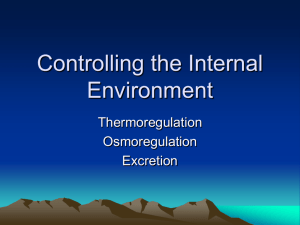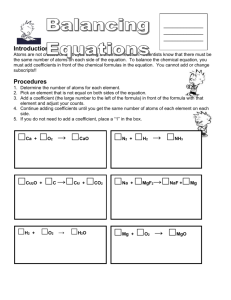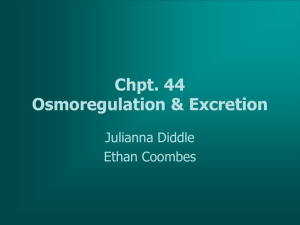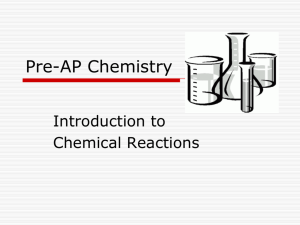Osmoregulation in a freshwater fish
advertisement
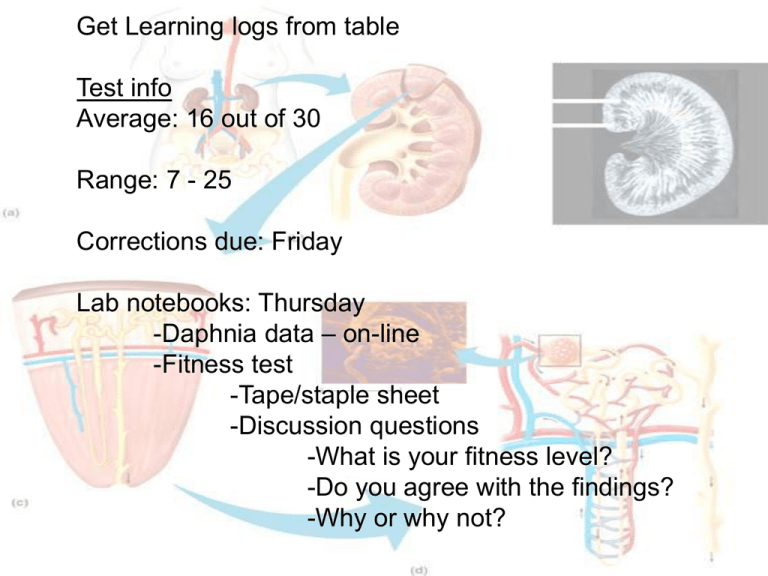
Get Learning logs from table Test info Average: 16 out of 30 Range: 7 - 25 Corrections due: Friday Lab notebooks: Thursday -Daphnia data – on-line -Fitness test -Tape/staple sheet -Discussion questions -What is your fitness level? -Do you agree with the findings? -Why or why not? Chapter 44: Osmoregulation and Excretion 1. What is osmoregulation? - How animals regulate solute concentrations & balance the gain & loss of water 2. What is excretion? - How animals get rid of nitrogenous waste of metabolism 3. What is the difference between an osmoregulator & an osmoconformer? - Osmoconformer – does not actively adjust its internal osmolarity - Isoosmotic to environment - Marine animals - Osmoregulator – actively controls osmolarity - NOT isoosmotic with environment Figure 44.3 Osmoregulation in marine and freshwater bony fishes Gain of water and salt ions from food and by drinking seawater Excretion of salt ions from gills Osmotic water loss through gills and other parts of body surface Excretion of salt ions and small amounts of water in scanty urine from kidneys (a) Osmoregulation in a saltwater fish - Hypoosmotic to ocean - loses LOTS of water at gills - “Drinks like a fish” - excretes salt & little urine Osmotic water gain through gills and other parts of body surface Uptake of water and some ions in food Uptake of salt ions by gills Excretion of large amounts of water in dilute urine from kidneys (b) Osmoregulation in a freshwater fish - Hyperosmotic to lake - gain LOTS of water at gills - LOTS of dilute urine Chapter 44: Osmoregulation and Excretion 1. 2. 3. 4. What is osmoregulation? What is excretion? What is the difference between an osmoregulator & an osmoconformer? What is the biggest issue for land animals? - Dehydration - Many adaptations to prevent this 5. What are the different nitrogenous waste products that animals excrete? - Ammonia - Urea - Uric acid Figure 44.8 Nitrogenous wastes Nucleic acids Proteins Nitrogenous bases Amino acids –NH2 Amino groups Ammonia – very soluble in water - VERY toxic - easily passes through membranes - 1 N at a time Many reptiles Most aquatic Mammals, most (including animals, including amphibians, sharks, birds), insects, most bony fishes some bony fishes land snails O NH3 Ammonia O C NH2 NH2 Urea O HN C C H C N C N N H H Uric acid C O Urea - 100,000X less toxic than –NH3 - -NH3 + CO2 in liver - helps conserve water - 2 N at a time Uric acid- not very soluble in water - excreted in paste-like form - little water loss - stored in amniotic egg - 4 N at a time Chapter 44: Osmoregulation and Excretion 1. 2. 3. 4. 5. 6. What is osmoregulation? What is excretion? What is the difference between an osmoregulator & an osmoconformer? What is the biggest issue for land animals? What are the different nitrogenous waste products that animals excrete? What are the 4 main functions of excretory systems? - Filtration - Reabsorption - Secretion - Excretion Figure 44.9 Key functions of excretory systems: an overview Capillary Filtrate Excretory tubule 1 Filtration. The excretory tubule collects a filtrate from the blood. Water and solutes are forced by blood pressure across the selectively permeable membranes of a cluster of capillaries and into the excretory tubule. 2 Reabsorption. The transport epithelium reclaims valuable substances from the filtrate and returns them to the body fluids. 3 Secretion. Other substances, such as toxins and excess ions, are extracted from body fluids and added to the contents of the excretory tubule. Urine 4 Excretion. The filtrate leaves the system and the body. Chapter 44: Osmoregulation and Excretion 1. 2. 3. 4. 5. 6. 7. What is osmoregulation? What is excretion? What is the difference between an osmoregulator & an osmoconformer? What is the biggest issue for land animals? What are the different nitrogenous waste products that animals excrete? What are the 4 main functions of excretory systems? How have excretory systems evolved? - Protonephridia – Planaria - Metanephridia – Earthworm - Malpighian tubules – insects - Kidney - us Figure 44.10 Protonephridia: the flame-bulb system of a planarian Nucleus of cap cell Cilia Interstitial fluid filters through membrane where cap cell and tubule cell interdigitate (interlock) Tubule cell Flame bulb Protonephridia (tubules) Tubule Nephridiopore in body wall Figure 44.11 Metanephridia of an earthworm Coelom Capillary network Bladder Collecting tubule Nephridiopore Nephrostome Metanephridia Figure 44.12 Malpighian tubules of insects Digestive tract Rectum Intestine Midgut (stomach) Salt, water, and nitrogenous wastes Hindgut Malpighian tubules Feces and urine Anus Malpighian tubule Rectum Reabsorption of H2O, ions, and valuable organic molecules HEMOLYMPH Chapter 44: Osmoregulation and Excretion 1. 2. 3. 4. 5. 6. 7. 8. What is osmoregulation? What is excretion? What is the difference between an osmoregulator & an osmoconformer? What is the biggest issue for land animals? What are the different nitrogenous waste products that animals excrete? What are the 4 main functions of excretory systems? How have excretory systems evolved? What is the structure and function of the kidney? Figure 44.13 The mammalian excretory system Posterior vena cava Renal artery and vein Aorta Renal medulla Renal cortex Kidney Ureter Urinary bladder Urethra Renal pelvis (a) Excretory organs and major associated blood vessels JuxtaCortical medullary nephron nephron Ureter (b) Kidney structure Afferent arteriole from renal Glomerulus artery Bowman’s capsule Proximal tubule Renal cortex Collecting duct To renal pelvis (c) Nephron Peritubular capillaries 20 µm Renal medulla Section of kidney from a rat SEM Efferent arteriole from glomerulus Branch of renal vein Descending Loop limb of Ascending Henle limb (d) Filtrate and blood flow Distal tubule Collecting duct Vasa recta Chapter 44: Osmoregulation and Excretion 1. 2. 3. 4. 5. 6. 7. 8. 9. What is osmoregulation? What is excretion? What is the difference between an osmoregulator & an osmoconformer? What is the biggest issue for land animals? What are the different nitrogenous waste products that animals excrete? What are the 4 main functions of excretory systems? How have excretory systems evolved? What is the structure and function of the kidney? What is the structure & function of the nephron? Chapter 44: Osmoregulation and Excretion 1. 2. 3. 4. 5. 6. 7. 8. 9. What is osmoregulation? What is excretion? What is the difference between an osmoregulator & an osmoconformer? What is the biggest issue for land animals? What are the different nitrogenous waste products that animals excrete? What are the 4 main functions of excretory systems? How have excretory systems evolved? What is the structure and function of the kidney? What is the structure & function of the nephron? - Glomerulus – filtration due to BP - Proximal tubule – secretion & reabsorption - Loop of Henle - Descending – reabsorption - Ascending – reabsorption - Distal tubule – secretion & reabsorption - Collecting duct - reabsorption Figure 44.14 The nephron and collecting duct: regional functions of the transport epithelium 1 Proximal tubule NaCl Nutrients HCO3 H2O K+ H+ NH3 4 Distal tubule NaCl H2O HCO3 K+ H+ CORTEX Filtrate H2O Salts (NaCl and others) HCO3– H+ Urea Glucose; amino acids Some drugs 2 Descending limb of loop of Henle 3 Thick segment of ascending limb NaCl H2O OUTER MEDULLA NaCl 3 Thin segment of ascending limbs Key Active transport Passive transport 5 Collecting duct Urea NaCl INNER MEDULLA H2O Chapter 44: Osmoregulation and Excretion 1. What is osmoregulation? 2. What is excretion? 3. What is the difference between an osmoregulator & an osmoconformer? 4. What is the biggest issue for land animals? 5. What are the different nitrogenous waste products that animals excrete? 6. What are the 4 main functions of excretory systems? 7. How have excretory systems evolved? 8. What is the structure and function of the kidney? 9. What is the structure & function of the nephron? 10. What causes the movement of water out of the filtrate? - Increasing salt concentration within the kidney Figure 44.15 How the human kidney concentrates urine Osmolarity of interstitial fluid (mosm/L) 300 100 300 100 CORTEX H2O Active transport H2O Passive transport H2O OUTER MEDULLA H2O 300 300 400 200 400 400 600 400 600 600 900 700 H2O H2O INNER MEDULLA 900 H2O 1200 1200 1200 Figure 44.15 How the human kidney concentrates urine Osmolarity of interstitial fluid (mosm/L) 300 100 300 100 CORTEX H2O Active transport H2O Passive transport H2O OUTER MEDULLA H2O INNER MEDULLA H2O 300 200 400 400 400 600 600 Nacl 400 Nacl Nacl Nacl 600 H2O H2O 300 Nacl 900 Nacl 900 700 Nacl 1200 1200 1200 Figure 44.15 How the human kidney concentrates urine Osmolarity of interstitial fluid (mosm/L) 300 100 300 100 CORTEX H2O Active transport H2O Passive transport H2O OUTER MEDULLA H2O Nacl 400 Nacl 600 INNER MEDULLA H2O 200 Nacl Nacl H2O 400 400 600 600 H2O 400 Nacl 900 300 H2O Nacl H2O H2O Nacl 300 700 H2O H2O Urea H2O Urea H2O Urea 900 1200 1200 1200 Chapter 44: Osmoregulation and Excretion 1. What is osmoregulation? 2. What is excretion? 3. What is the difference between an osmoregulator & an osmoconformer? 4. What is the biggest issue for land animals? 5. What are the different nitrogenous waste products that animals excrete? 6. What are the 4 main functions of excretory systems? 7. How have excretory systems evolved? 8. What is the structure and function of the kidney? 9. What is the structure & function of the nephron? 10. What causes the movement of water out of the filtrate? 11. How is blood osmolarity regulation? - ADH - RAAS Figure 44.16 Hormonal control of the kidney by negative feedback circuits Osmoreceptors in hypothalamus Homeostasis: Blood pressure, volume Thirst Hypothalamus Drinking reduces blood osmolarity to set point Increased Na+ and H2O reabsorption in distal tubules STIMULUS: The juxtaglomerular apparatus (JGA) responds to low blood volume or blood pressure (such as due to dehydration or loss of blood) ADH Increased permeability Pituitary gland Aldosterone Distal tubule Arteriole constriction Adrenal gland STIMULUS: The release of ADH is triggered when osmoreceptor cells in the hypothalamus detect an increase in the osmolarity of the blood H2O reabsorption helps prevent further osmolarity increase Angiotensin II Distal tubule Collecting duct Homeostasis: Blood osmolarity (a) Antidiuretic hormone (ADH) enhances fluid retention by making the kidneys reclaim more water. Angiotensinogen JGA Renin production Renin (b) The renin-angiotensin-aldosterone system (RAAS) leads to an increase in blood volume and pressure.
